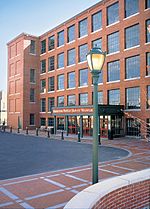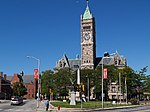Holy Trinity Greek Orthodox Church (Lowell, Massachusetts)

Holy Trinity Greek Orthodox Church is a historic Greek Orthodox Church building at 62 Lewis Street in Lowell, Massachusetts. Holy Trinity is one of the many Eastern Orthodox churches in Lowell, along with St. George Antiochian Orthodox Church, Transfiguration of Our Savior Greek Orthodox Church, and St. George Greek Orthodox Church. The church is under the jurisdiction of the Greek Orthodox Archdiocese of America and is locally administered by the Metropolis of Boston. The church is located the Downtown Lowell neighborhood known as The Acre. It was built in 1906 and added to the National Register of Historic Places in 1977. Holy Trinity was the first church built for a Greek Orthodox congregation in the United States. It is known for its golden dome, mosaics, iconography, and rich history. Archbishop Iakovos of America, who led the Greek Orthodox Archdiocese of America from 1959 through 1996, was ordained as a priest at Holy Trinity on June 16, 1940.
Excerpt from the Wikipedia article Holy Trinity Greek Orthodox Church (Lowell, Massachusetts) (License: CC BY-SA 3.0, Authors, Images).Holy Trinity Greek Orthodox Church (Lowell, Massachusetts)
Jefferson Street, Lowell The Acre
Geographical coordinates (GPS) Address Nearby Places Show on map
Geographical coordinates (GPS)
| Latitude | Longitude |
|---|---|
| N 42.645555555556 ° | E -71.317222222222 ° |
Address
Jefferson Street
Jefferson Street
01850 Lowell, The Acre
Massachusetts, United States
Open on Google Maps










